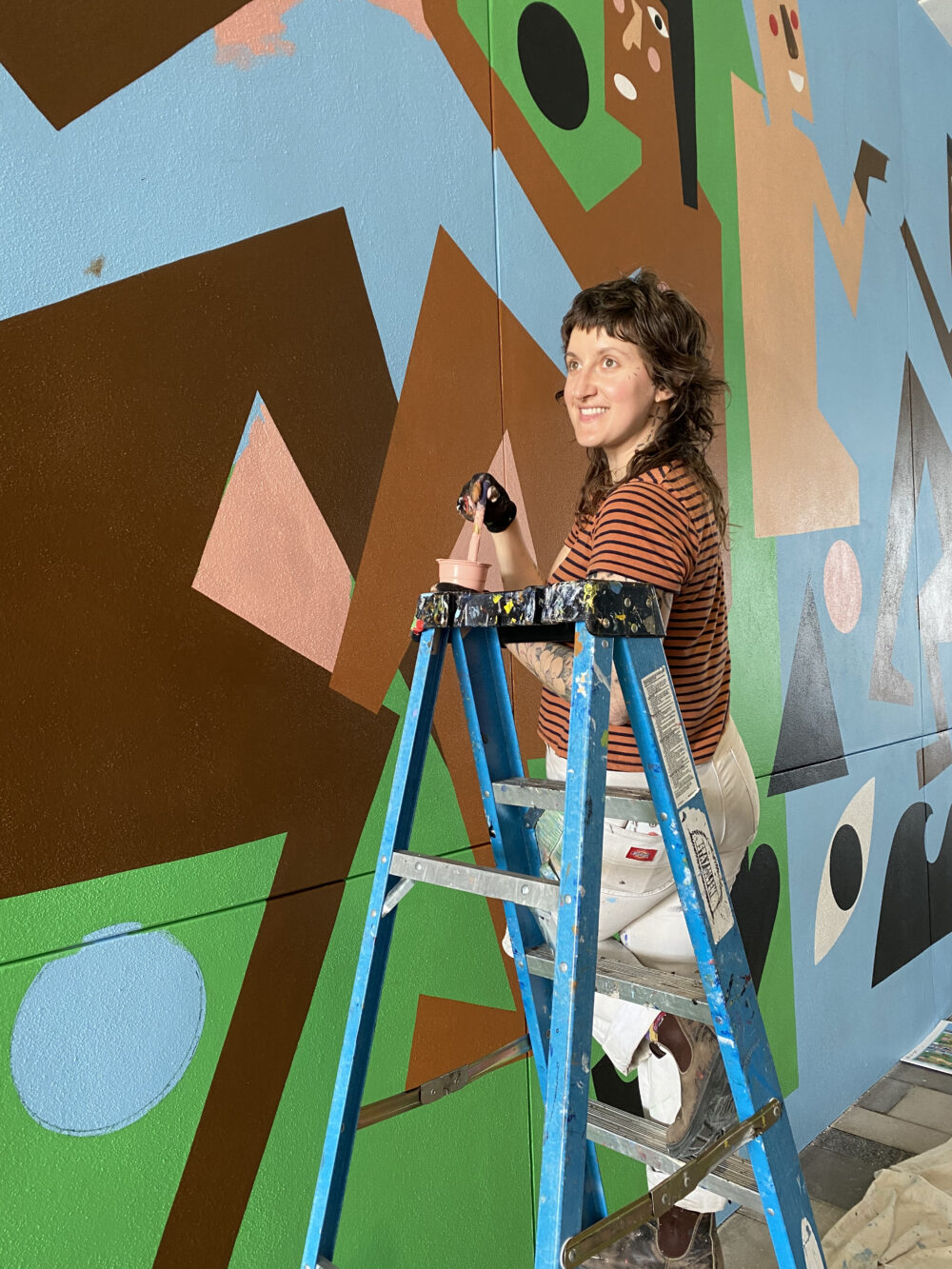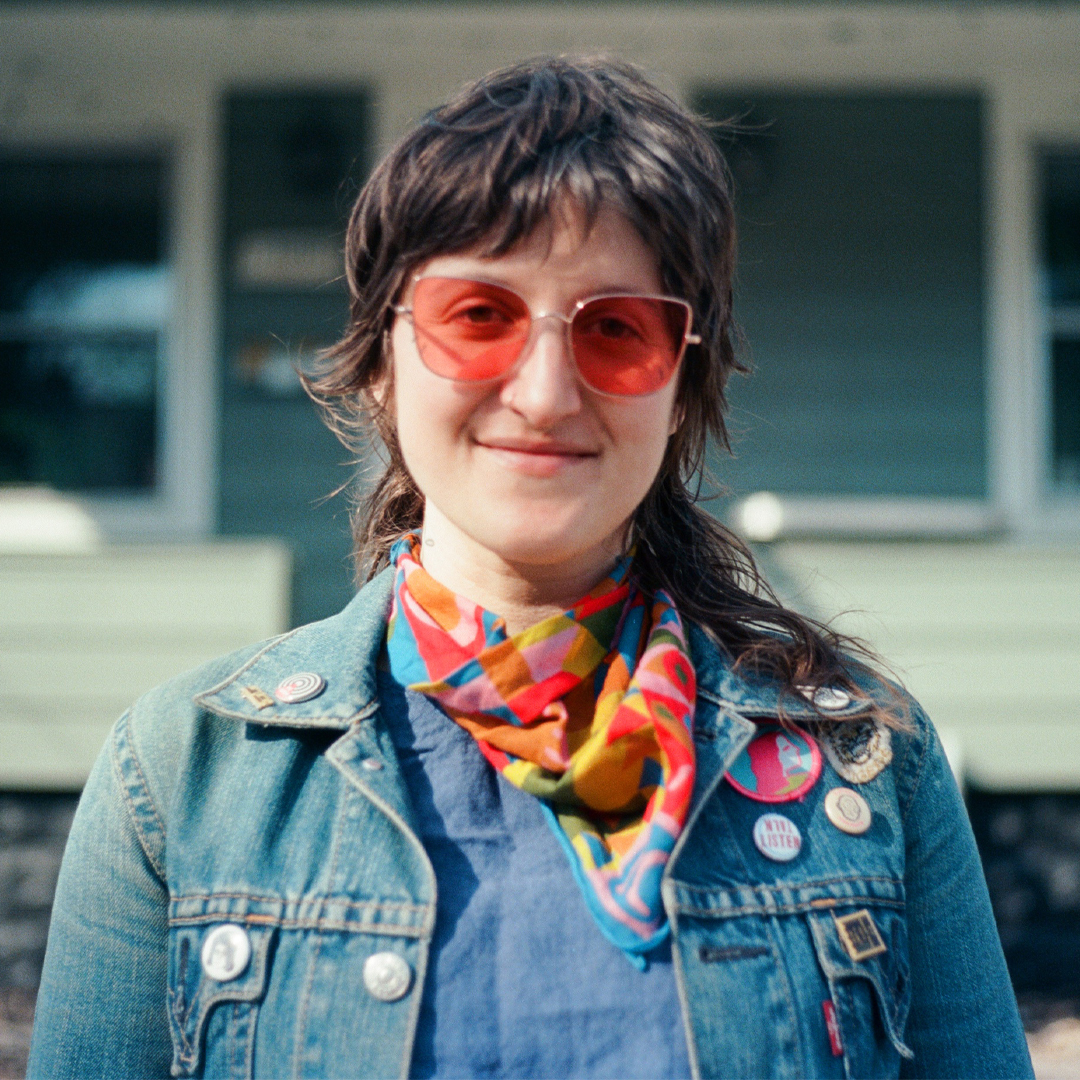the lessons
of


“There is nothing new under the sun, but there are new suns.” –Octavia Butler

7 minute listen, or the time it takes to walk to a corner store.
BY SHELBY RODEFFER
For some people, viewing a sign is just another moment of living in a man-made environment. The space between the eye scanning the information and the brain processing it is collapsed. When we slow down, we realize the assumptions we’ve made in glazing over what’s in front of us. Simply following letterforms can lead us to feel out entire new meanings. We can question the world around us in a playful and insightful way, as Shelby Rodeffer demonstrates and reflects upon in sign painting.

Nadine Nakanishi: How did you get into sign painting?
Shelby Rodeffer: In college, I began exploring hand-drawn lettering. I was majoring in illustration, and I was frustrated with the incongruence of using static fonts with images that I had drawn. Naturally, the solution was to also draw the text! In 2012, the book Sign Painters, companion to the documentary of the same name by Faythe Levine and Sam Macon, began getting press, and it blew my mind wide open. I had grown up in a tiny town where so many of the signs were hand-painted, but I had never considered the tradespeople behind hand-painted signs. Turns out, the sign painter in my hometown was my great grand-uncle, Felix Bellar of Adams, Tennessee. He died before I got to know him, but I have spent a lot of time archiving his surviving work in Robertson County. Attaching a person to the aesthetics of my hometown suddenly made the provincial farm region come alive. Felix had a distinct calligraphic style and a very limited color palette. His work is unmistakable to me now and I could pick his signs out of a lineup.
I remember that I was working in a letterpress shop in Nashville at the same time that I became aware of sign painting. The shop was a known drop-in spot for visiting artists, and Wayne White (of Pee Wee’s Playhouse fame, and an incredible text-based painter) was in town for a few weeks doing a puppet workshop. I was digging out some paper and drawing utensils for Wayne to use while he waited for our lunch break when my boss said, “Hey Wayne, you used to paint those billboards for the science center when you lived out here, right? Well, Shelby wants to be a sign painter. Got any advice for her?” Wayne said, “Yeah, don’t do it.” He lamented the hours of backbreaking work out in the elements painting billboards and ascribed it closer to a career in construction than in the arts. But my mind was already made up, and a year later I moved to Chicago to learn everything I could about sign painting. I had taken on any sign work I could get in Nashville, but I was struggling to master any semblance of technique without a teacher. Chicago has had a global impact on sign painting techniques, and at one time was home to several sign painting schools. Moving to Chicago gave me access to veterans and masters of the trade and a community of peers who were also developing their skills in a renaissance of the craft.
[Video Description: Scenes from an artist’s studio while they work in its various spaces. The artist scrolls through images on their desktop, sketches on a iPad, and uses an electro-pounce machine to perforate a pattern that reads, “Commonwealth when wealth is common,” onto a sheet of paper attached to a metal easel. They then use a pounce pad to transfer the pounced pattern onto a piece of wood that has been cut to size, sanded, primed, and painted with a coat of enamel paint.]
Nadine: What spoke to you about the saying “Common Wealth”?
Shelby: I now live in Louisville, Kentucky, and I truly love it here. Chicago was a great place to cut my teeth, but I was missing the South. Louisville straddles both worlds: there’s a bar on every corner like the Midwest, but the accents and hospitality of the South are here. In my time in Chicago, I learned about the Haymarket Riots, and in Kentucky I’ve been learning about the Coal Wars of Harlan County, with union organizers and laborers fighting bloody battles for better wages and working conditions. Several corporations in the Louisville area still operate like “company towns,” and unionization efforts and strikes for better treatment are evergreen. The United States is built on oppression of the working class, so no matter where you’re living you can find a similar history.

Kentucky refers to itself as a commonwealth, which is a phrase I hadn’t put much stock into until I found a drawing by Walter Crane called A Garland for May Day. The image depicts a woman in a winged helmet presenting a garland of Socialist ideals. One of the ribbons on the garland reads, “A Commonwealth when wealth is common.” In our Commonwealth of Kentucky, we see daily examples of how wealth is not a common experience. Bourbon barons and a gerrymandered government, plus lingering facets of Jim Crow and redlining means that so few have so much, and so many don’t have enough. I wanted to paint this phrase alone, to give breathing room to the concept, “A Commonwealth when wealth is common.”
[Video description: The artist mixes a series of paints and uses a mahl stick to support their wrist as they begin painting. The time-lapse video shows the artist carefully filling in the pounced outline with a series of brown, green, and pink paints to reveal the phrase, “Commonwealth when wealth is common,” framed by two loaves of bread, flowers, leaves, and other flourishes. The artist sprays the completed sign with cleaner to remove excess pounce lines and leave a glossy finish. The finished sign is placed outside, leaning against the base of a road sign.]
Rather than going the LIVE LAUGH LOVE route of text-based art, I hope that what I’m doing is using my skills as a sign painter to direct a spotlight onto concepts and feelings that either have a little bit of tension or are teetering on the brink of entropy.
Nadine: Can you walk us through a bit more of the process from digital to physical captured in your video? How do you go about the arrangement and composition? How do space and time play into the making for you in sign painting and in your general practice?
Shelby: While I love my analog trade, I am very comfortable with and tethered to current technology. My work sits in both worlds, with constant reference to the past and inspiration from the present and future. Almost everything I make is a reference or remix of something else: a song lyric, a slogan, an overheard conversation. My comfort zone involves taking something anachronistic and something current, and having those things coexist. Rather than going the LIVE LAUGH LOVE route of text-based art, I hope that what I’m doing is using my skills as a sign painter to direct a spotlight onto concepts and feelings that either have a little bit of tension or are teetering on the brink of entropy.
Before I paint a sign, I like to compose it in a digital program, which is either Procreate on my iPad, or Adobe Illustrator on my computer. I’m able to push things around and scale elements up and down until I’m happy with the composition, which saves paper and wear on my drawing wrist. No matter how much time I’m able to save with conceptualizing a sign, it is always a labor of love to paint one. There are ways to speed this along that don’t appeal to me, such as using vinyl masks. I relish the opportunity to move slowly and deliberately, at the mercy of enamel paint drying speeds… and that’s just for the cozy work in my studio. When I’m painting on-site for clients in the world, I am also subject to weather (wind, precipitation, and temperature can combine in a million inhospitable ways that confound me), noise, and an audience (“You spelled that wrong!” and “I can’t even draw a stick figure!”) — exactly what Wayne had warned me about twelve years ago. I am always grounded in the lesson that a hand-painted sign takes its time and forces me to do the same.

[ID: Shelby smiles at the camera, wearing pink-tinted glasses and a colorful bandana.]
Shelby Rodeffer
She // Her // Hers
They // Them // Theirs
Louisville, KY
Shelby Rodeffer is a Kentucky-based artist specializing in traditional sign painting and gilding, handmade banners, murals, and other painted works. In the twelve years that Rodeffer has been in practice, she has shown work nationally and internationally, curated group exhibitions, and created more than thirty hand-painted signs and murals, many of which can be seen in public spaces and on storefronts across the United States.
Rodeffer is the owner and principal painter of Finer Signs, which has created work for notable clients including Warby Parker, Pitchfork Music Festival, and Coca Cola. However, Finer Signs prioritizes opportunities to collaborate with small businesses and local non-profit organizations, whether through custom signage and public artwork to increase their visibility in the community or through no- or low-cost workshops for youth, beginning artists, and those interested in the traditional crafts of hand-lettering and sign painting.
shelbyrodeffer.com
finersigns.com
Instagram: @smellby and @finersigns
